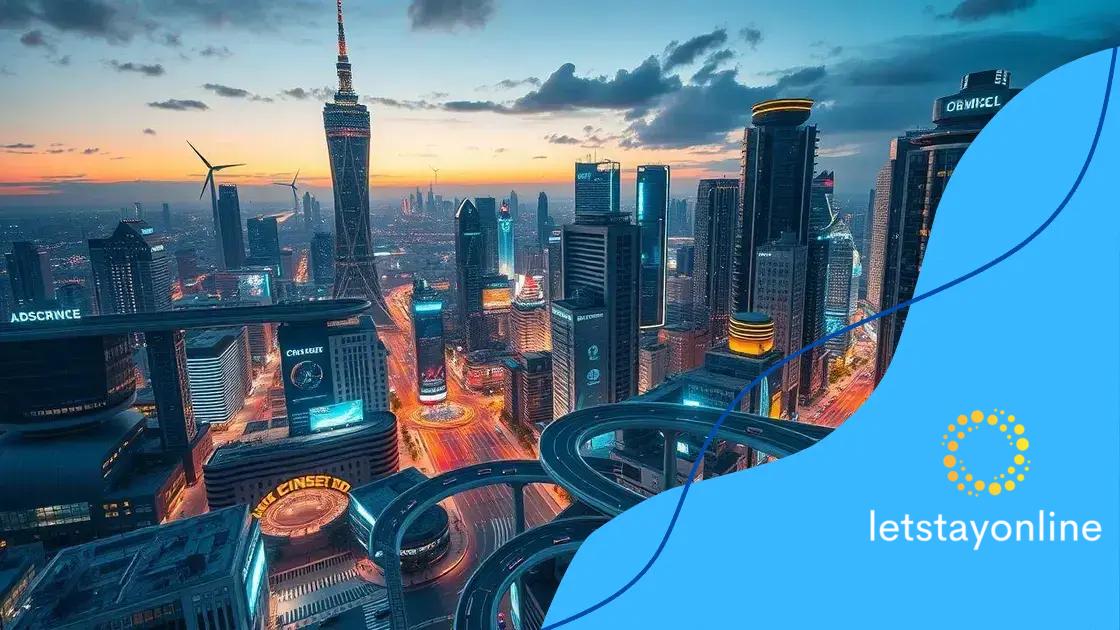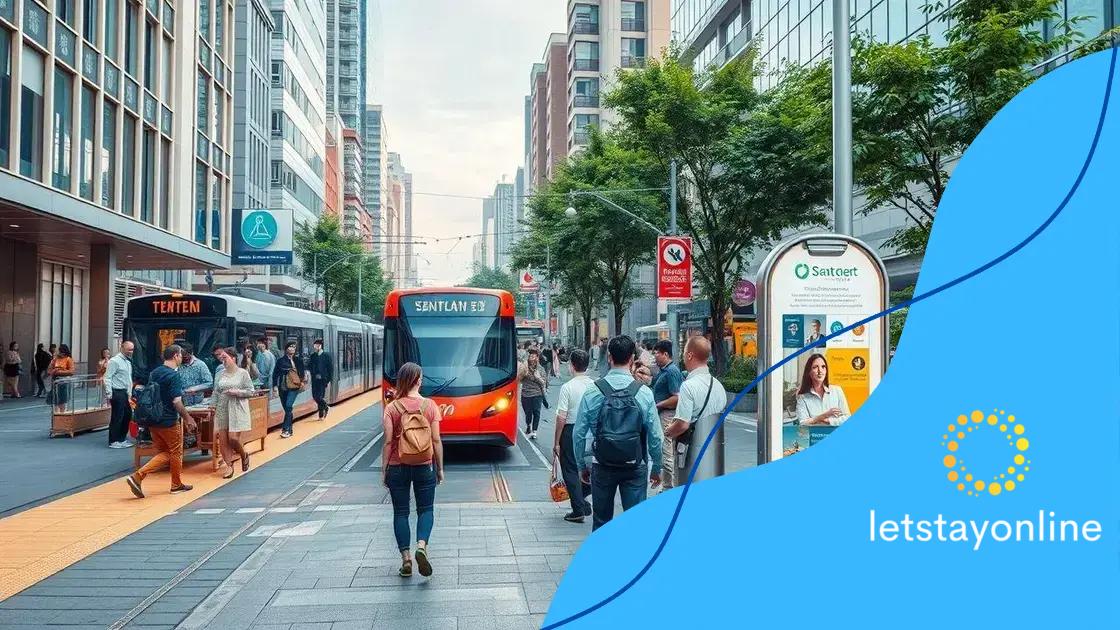The impact of smart cities on urban development

The impact of smart cities on urban development includes enhanced quality of life for residents, improved business efficiency, sustainable practices, and the integration of advanced technologies that reshape urban living environments.
The impact of smart cities on urban development is something many of us may not fully grasp. Have you ever wondered how these innovative concepts could change our daily lives? Let’s dive into what makes a city smart and why it matters.
Defining smart cities and their core components
Understanding what defines smart cities is essential in today’s rapidly changing urban landscape. These cities are reimagining how we interact with our environment, leveraging technology to enhance the quality of life.
Core Components of Smart Cities
Several key features characterize smart cities and set them apart. First, they utilize data-driven technologies to improve city management and services. This involves integrating IoT devices to gather real-time data across various sectors.
Key Features to Note
- Robust infrastructure: Advanced systems for transport, energy, and communication.
- Citizen engagement: Platforms that allow residents to participate in decision-making.
- Sustainability: Efforts to minimize environmental impact through smart energy solutions.
- Data analytics: Using information to make informed decisions for urban planning.
A strong emphasis on sustainability makes smart cities a viable option for future growth. With green technologies, they aim to reduce carbon footprints and manage resources efficiently. By adopting renewable energy sources and enhancing public transport systems, they create a more livable urban environment.
Moreover, smart cities foster innovation by creating a collaborative atmosphere for businesses and startups. They integrate technology into everyday city functions, from traffic management to waste disposal, which streamlines operations and enhances service delivery. This progressive approach helps cities adapt to changing needs and prepares them for future challenges.
Ultimately, smart cities not only improve efficiency but also enrich the community’s social fabric. Residents benefit from enhanced public services and stronger community ties, with the ability to access information and services seamlessly. By understanding the core components of smart cities, we can appreciate their potential to transform urban living.
Key technologies driving smart urban development
Key technologies are essential for driving smart urban development. These technologies create efficiencies and enhance the quality of urban life, making it essential to explore their impact.
Internet of Things (IoT)
The Internet of Things connects everyday objects to the internet. This allows for real-time data collection and sharing. Sensors on streetlights can adjust brightness based on traffic, significantly reducing energy costs.
Data Analytics
Data analytics plays a vital role in smart cities. By analyzing data, city officials can make better decisions that cater to citizens’ needs. For instance, analyzing traffic patterns can lead to improved transportation routes, making commutes faster and safer.
- Monitoring air quality to ensure a healthier environment.
- Tracking public transport usage to optimize schedules.
- Evaluating service requests to enhance responsiveness.
Another important technology is artificial intelligence (AI). AI can help city planners predict population growth and identify potential issues before they arise. Algorithms can analyze large sets of data to determine the best locations for new schools or parks, ensuring that new developments meet community needs.
Additionally, renewable energy technologies are crucial in reducing a city’s carbon footprint. Cities increasingly rely on solar panels and wind turbines, which provide clean energy while decreasing dependence on fossil fuels. This not only benefits the environment but also promotes energy independence.
Mobile applications also enhance urban experiences. These apps allow residents to report issues like potholes or broken streetlights quickly, connecting them directly with city services. By engaging citizens through technology, cities foster a sense of community and responsibility.
In summary, the combination of IoT, data analytics, AI, and renewable energies creates a framework for successful smart urban development. As these technologies advance, cities become more efficient and adaptable to the needs of their citizens.
Benefits of smart cities for residents and businesses

The benefits of smart cities extend to both residents and businesses, improving the quality of life and driving economic growth. These cities harness technology to create more vibrant, sustainable environments.
Enhanced Quality of Life
For residents, living in a smart city means access to better services and amenities. Smart technology enables improved public transportation. For example, real-time tracking of buses and trains helps reduce waiting times, making commutes less stressful.
Increased Efficiency
Additionally, smart cities offer enhanced access to information. Mobile applications provide updates on city services, from waste collection to event notifications. This fosters a sense of community engagement and participation.
- Improved public safety through smart surveillance systems.
- Access to parks and recreational facilities that monitor usage for enhancements.
- Health initiatives that promote wellness through connected services.
For businesses, smart cities create an attractive environment for investment. With efficient infrastructure and high-quality services, companies can operate more effectively. The integration of technology leads to less downtime, reducing operational costs.
Companies in smart cities also benefit from innovation hubs. These are areas where startups and established companies collaborate, fostering creativity and technological advancements. Such environments promote economic growth and job creation.
Moreover, sustainable practices championed by smart cities, like energy efficiency programs, not only help the environment but can also reduce costs for businesses. By adopting green technologies, companies can enhance their public image while saving money.
Ultimately, smart cities bridge the gap between residents and businesses. By creating a connected ecosystem, everyone benefits from enhanced services, greater efficiency, and a more vibrant urban experience. This mutual growth is essential for thriving modern communities.
Challenges faced by cities in becoming smart
While the shift to smart cities offers numerous benefits, it also presents several challenges that urban areas must address. Identifying and overcoming these obstacles is crucial for successful implementation.
Infrastructure Limitations
One major challenge is outdated infrastructure. Many cities still rely on systems that are not designed for modern technologies. Upgrading these systems can be cost-prohibitive and time-consuming.
Funding and Budget Constraints
Another significant barrier is funding. Smart city initiatives often require substantial upfront investment, which can be difficult for cash-strapped municipalities. Without adequate financial support, projects may stall or fail to launch.
- Limited resources for maintenance and upgrades.
- Dependence on government grants and public-private partnerships.
- Challenges in prioritizing technology over basic services.
Data privacy and security are also pressing concerns. As cities collect vast amounts of data from residents, ensuring that this information is protected is essential. The risk of data breaches can lead to distrust among the public, hindering adoption.
Furthermore, integrating various technologies presents technical complexities. Different systems need to work seamlessly together, but compatibility issues often arise. Cities must prioritize fostering partnerships with technology providers to create cohesive solutions.
Lastly, public engagement plays a vital role in the transition. Many residents may be unaware of the benefits of smart technologies or resistant to change. Educating communities and involving citizens in the planning process is crucial for gaining support.
Overall, while the path to becoming a smart city is fraught with challenges, addressing these issues is vital for harnessing the potential of technology in urban environments.
Future trends in urban development and smart technologies
As we look toward the future, several trends are shaping urban development and the integration of smart technologies in cities around the world. Recognizing these trends is essential for understanding how cities will evolve in the coming years.
Increased Use of Artificial Intelligence
One significant trend is the rising use of artificial intelligence (AI)
Sustainability will also play a critical role in future urban development. Cities will increasingly adopt green technologies, focusing on reducing their carbon footprint. Initiatives may include solar energy installations and energy-efficient buildings, which are designed to consume less energy. Moreover, the demand for smart public services will grow. Citizens will expect seamless access to services like waste management, parking, and public transportation through mobile applications. This demand is pushing cities to invest heavily in digital infrastructure. Another emerging trend is community engagement through technology. Cities will prioritize involving residents in decision-making processes using digital platforms. These tools will help gather feedback and foster community collaboration while enhancing transparency. Signals for these shifts are already evident. Cities worldwide are implementing pilot projects that leverage technology for better living standards. These projects not only demonstrate the potential of smart technologies but also pave the way for wider adoption. Ultimately, the future of urban development lies in the effective integration of technology with traditional city planning. As cities embrace innovation, they will become more resilient, efficient, and responsive to the needs of their residents. Smart cities use advanced technology and data to improve city services and enhance the quality of life for residents. Smart technologies improve public services, reduce traffic congestion, and provide real-time access to information, making urban living more efficient. Cities often encounter funding issues, outdated infrastructure, and the need for public engagement when implementing smart technologies. Future trends include increased use of artificial intelligence, sustainable practices, and enhanced community engagement through technology.Growth of Sustainable Practices
FAQ – Frequently Asked Questions about Smart Cities and Urban Development
What are smart cities?
How do smart technologies benefit residents?
What challenges do cities face when becoming smart?
What future trends should we expect in urban development?






